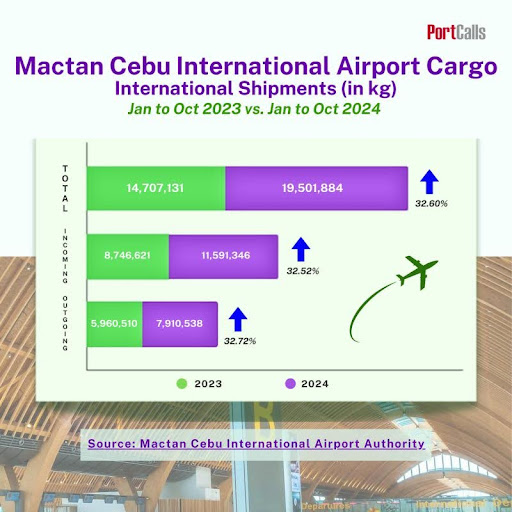
The year 2024 saw remarkable double-digit growth in airport cargo volumes at two of the Philippines’ busiest airports, Ninoy Aquino International Airport (NAIA) and Mactan-Cebu International Airport (MCIA). These increases are pivotal for bolstering the country’s logistics capabilities this year 2025 and supporting its economic growth.
Record-Setting Airport Cargo Growth at Two Key Philippine Airports
Notably, NAIA reported a stunning 31.2% rise in airport cargo handled, reaching 616,478.52 metric tons (mt), while MCIA recorded an 18.1% increase, amounting to 68.530 million kilograms (kg). This article dives into the numbers behind this growth and examines the factors driving the surge.
Airport Cargo Volume Growth at NAIA

What is the Current Situation at NAIA?
NAIA experienced a significant airport cargo increase of 31.2% in 2024, up from 544,774.32 mt in 2023. In particular, international cargo constituted a major segment, accounting for 65.6% or approximately 404,607.93 mt, a 16.7% rise from the previous year. Domestic cargoes, on the other hand, rose by 7% to 211,870.59 mt from 197,941.61 mt in 2023.
Supporting Evidence and Impact
Data from the Manila International Airport Authority attributes this growth to an array of factors, including robust economic activities and enhanced airport operations. Furthermore, NAIA saw a 41.2% increase in flights, a significant contributor to cargo handling efficiency. Domestic flights surged by 70.3%, while international flights saw an 11.6% rise.
Practical Applications
The upsurge in cargo at NAIA is indicative of greater trade volumes, supporting domestic supply chains and international trade. This growth likely signals increased business for freight forwarders, importers, and exporters, marking a vibrant post-pandemic recovery.
Airport Cargo Handling Surge at MCIA

How is MCIA Faring?
In 2024, MCIA recorded an 18.1% growth in cargo volume, reaching 68.530 million kg from 58.011 million kg in 2023. Domestic cargoes formed 65.5% of this total, registering a 13% increase, while international cargoes expanded 29.2% to 23.665 million kg.
Statistical Insights and Operational Growth
According to data from the Mactan-Cebu International Airport Authority, MCIA’s flights grew by 10.5% to 99,149 in 2024. This includes a 12% increase in domestic flights and a 5% upswing in international flights. These numbers reflect the strategic enhancements in airport infrastructure and capacity.
Practical Impact and Developments
MCIA’s introduction of a 2.56-kilometer alternate runway is a strategic move to accommodate rising air traffic and cargo volumes. Both runways are projected to be fully operational by 2028, which will significantly boost the airport’s capacity to handle up to 18 million passengers annually.
Beneficiaries of the Cargo Surge: Logistics Companies Poised for Growth
The substantial increase in airport cargo volumes at NAIA and MCIA in 2024 presents significant opportunities for logistics companies operating in and around these major transport hubs. By facilitating the movement of goods, these companies are essential in capitalizing on rising demands and ensuring efficient supply chain processes. Notably, several logistics firms are well-positioned to benefit from this uptick in activity.
How Logistics Companies Stand to Gain
 |
Transportify: A leading logistics company offering on-demand delivery services, is among the firms poised to benefit substantially from the cargo volume surge. With its flexible platform that connects businesses to a vast network of vehicles and drivers, Transportify is well-equipped to handle increased domestic distribution needs. The company’s ability to manage a wide range of delivery requirements makes it an integral player in ensuring timely and efficient cargo handling across the country. |
 |
LBC Express: As a staple in the Philippine logistics industry, LBC Express offers comprehensive services that include courier, freight forwarding, and logistics support. The growth in cargo volumes is likely to increase demand for LBC’s services, particularly for businesses seeking reliable delivery solutions. |
 |
DHL: With a strong international presence, DHL stands to gain from the surge in international cargo. Its extensive global network facilitates efficient import and export operations, making it a crucial partner for businesses looking to expand beyond domestic borders. |
 |
J&T Express: Known for its competitive pricing and wide reach across the Philippines, J&T Express is another company positioned to capitalize on increased cargo demands. Its focus on technology-driven logistics solutions aligns well with the growing needs for fast and reliable delivery services. |
Supporting Evidence and Future Prospects
The rise in cargo volumes at NAIA and MCIA highlights the necessity for robust logistics operations. According to industry experts, firms that leverage technology and efficient transport networks will lead in capitalizing on these growing opportunities. The World Bank outlines that the enhancement of infrastructure and logistics capabilities is crucial for sustaining economic development, suggesting that companies like Transportify and others are central to this trajectory.
Strategic Enhancements and Future Readiness
Infrastructure Developments and Streamlining Operations
Both NAIA and MCIA have undertaken notable infrastructure improvements to sustain growth. NAIA, managed by New NAIA Infra Corp, is focusing on operational efficiency to align with increasing passenger demands. Meanwhile, MCIA’s recent runway inauguration is a testimony to its commitment to meeting future air traffic demands.
Critical Next Steps for Stakeholders
The advancement in cargo volumes at both NAIA and MCIA accentuates a need for continuous investment in airport infrastructure and technology. Stakeholders including government bodies, airport authorities, and private operators should collaborate to bolster logistics capabilities, enhance cargo handling technologies, and expand airport capacities.
Sustaining the Momentum
The laudable growth in cargo volumes at NAIA and MCIA in 2024 demonstrates the potential of these airports as critical hubs in Southeast Asia. It highlights the importance of sustained infrastructure investments, operational enhancements, and strategic foresight in sustaining and amplifying this momentum. As both airports continue to evolve, they are poised to play pivotal roles in enhancing the Philippines’ standing in global trade dynamics.
